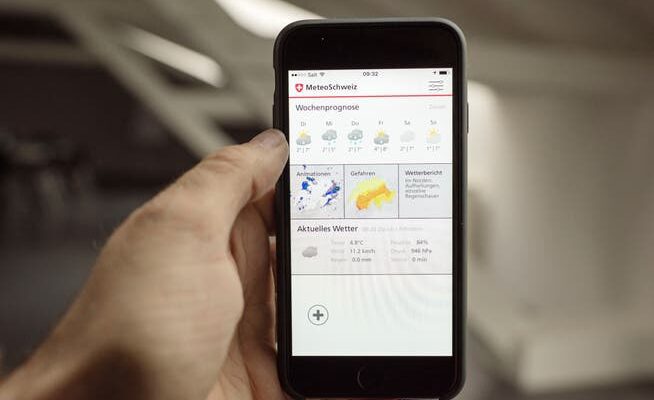Those who go on excursions consult their smartphones and the appropriate tools for the weather and hiking trails. This alienates us from the environment. But we must not forget how to read maps and clouds.
The Meteo Switzerland weather app on a smartphone, taken on January 5, 2016 in Zurich.
On Sunday morning, a look at the weather app on the cell phone shows: clear to cloudy. As it seems, nothing stands in the way of a winter hike in the mountains. Once in the area, the satellite navigation reveals which path we are currently on and how far it is to the next hut.
A similar picture in summer: When planning whether to invite people to a barbecue at the weekend, we also consult the weather app. A look at the rain radar reveals that the thunderstorm front is not to be expected until the night hours.
In the past, one would have consulted maps and studied weather reports beforehand. Today we conveniently rely on technical aids such as satellite positioning and computer simulations. Tools that are available anytime, anywhere – on devices that fit in a jacket pocket. This is a blessing and can make everyday life easier.
The tools on the cell phones lead to alienation
On the other hand, these apps gradually make you addicted: the more we use them, the more we lose the ability to find our way around in an often messy environment without high-tech, without simulations.
If people forget how to deal with nature, philosophers and sociologists describe this as a form of alienation. The regret, even the lamentation of cultural critics about this loss is old. Not infrequently, well-founded concerns turned into exaggerated cultural pessimism.
In recent years, however, mobile apps for almost every occasion have found their way into our everyday lives. Anyone who climbs a mountain, for example, can display the names of all visible peaks in the area. Ask locals? Superfluous! In view of this development, the question of whether alienation from nature has reached a new level has become more acute.
Don’t neglect basic skills
It makes a huge difference whether we feel our way through the terrain step by step with the help of an unwieldy paper map – or just a description of the route – or stare at our cell phone every few meters. Whether the app says that a snowstorm is coming or the cloudy sky reveals characteristic signs: there are worlds in between.
This is not an invitation to give yourself up to the elements again in a nature-romantic exuberance. Many cell phone tools are useful, they can save lives in an emergency. But despite all the enthusiasm for the wondrous tools, it still makes sense to save a selection of basic skills for the high-tech future.
Who remembers that an approaching thunderstorm can be recognized by the anvil shape of the cloud? Who can find themselves on a paper hiking map when they are lost? Skills like these not only have a practical use, for example if the cell phone battery is empty or the satellite navigation system should fail.
Can read the environment
The information that can be gleaned from an app on a cell phone has an extremely high degree of abstraction. Like the ready-made pizzas in the refrigerated section, they are only a poor imitation of the original. Not only that: Apps often pretend to be accurate, which they don’t even maintain. A hiking trail may have been buried by a debris flow that has not yet been mapped. A sudden wind shift can bring about a change in the weather in the Alps, which did not occur in the simulations.
Let’s do the reality check again and again. When we get a chance, let’s test our ability to read the environment and find our way around in it. Let’s plan a harmless hike without a cell phone, walk through the forest for a while while the magic device is switched off.
The better we understand with all our senses what the great apps actually do for us and where they can go wrong, the better we understand the differences between raw reality, the maps and the simulations. And the more sensibly we can use the tools if we really need them.
